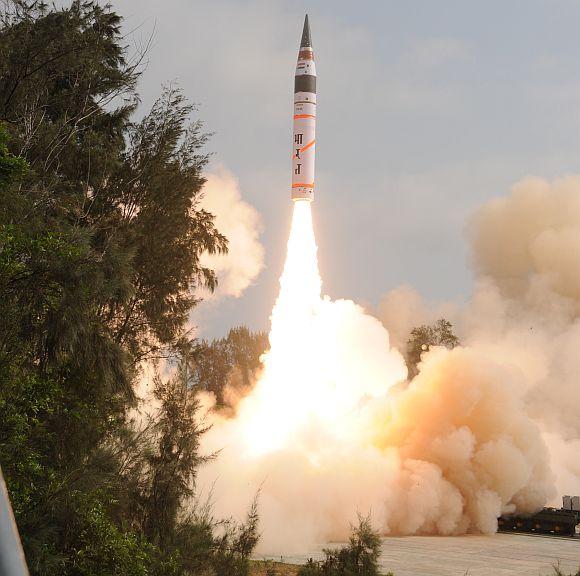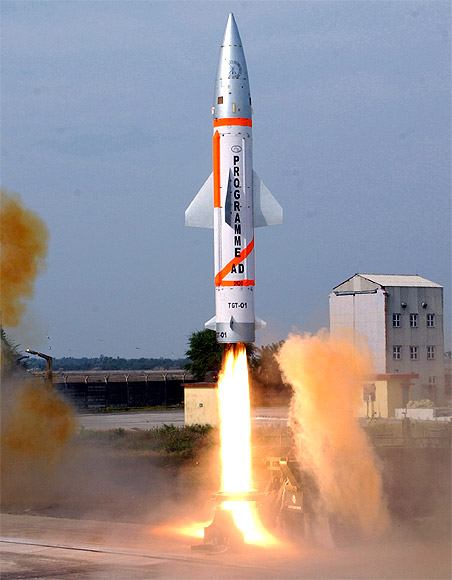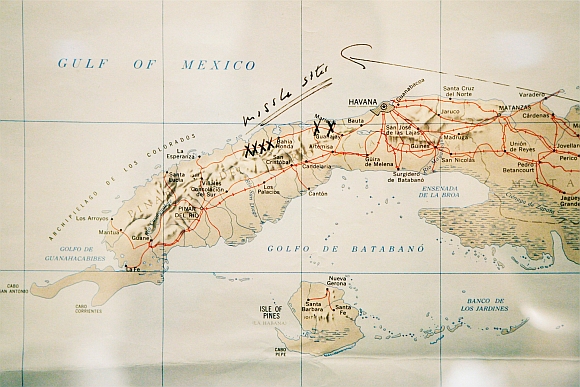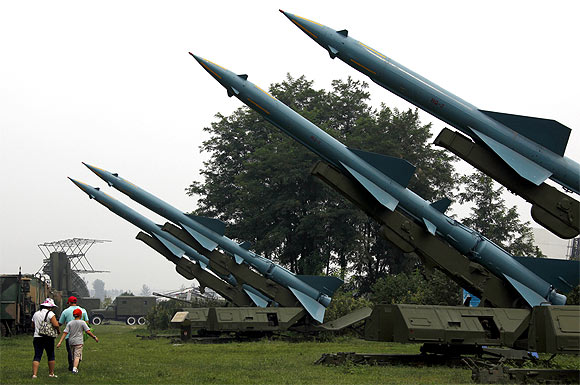Photographs: PIB Photo Praful Bidwai
Nuclear-tipped missiles don't give security, says Praful Bidwai
Such is the strength of chauvinist hyper-nationalism in India and Pakistan that the launch of the Agni-V, officially called an Intercontinental Ballistic Missile, followed by the Hatf-IV-Shaheen-1A launch in Pakistan, was greeted with machismo, raucous celebration and sabre-rattling.
Most Indian political parties lavished praise on Defence Research and Development Organisation personnel for their "scientific achievement", without pausing to ask how replicating a 1950s-vintage technology constitutes something original, and why such 'achievements' are typically confined to mass-destruction weapons alone.
Not a single party criticised the hysterical triumphalism evident in much of the media, which described the launch as a 'giant leap' for indigenous technology and a 'game-changer'. None warned against the dangers of a missile and nuclear arms race which can badly destabilise this region. Even the hostile reaction from The Global Times in China didn't generate a more sober response other than that India shouldn't treat the Agni-V as anything but a 'deterrent'.
The state-run Chinese paper scathingly said India was being swept by a 'missile delusion', but stands 'no chance in an overall arms race with China' and would 'gain nothing by stirring further hostility'.
Even if India has missiles that could reach most parts of China, 'that does not mean it will gain anything from being arrogant during disputes with China. India should be clear that China's nuclear power is stronger and more reliable... India should also not overstate the value of its Western allies and the profits it could gain from participating in a containment of China'.
Whatever the merits of this view, it's clear that not just Pakistan, but China too, views India's ballistic missile programme as a strategic threat, and will react to it. After all, the Agni-V is designed to reach Beijing, Shanghai and cities in eastern China. China's retaliatory response will extract a price. Amidst the euphoria, nobody talks about this.
...
The euphoria is unjustified
Image: A modified Prithvi missile, simulating the enemy target, is launchedPhotographs: Reuters
The euphoria is unjustified for other reasons too. India's Integrated Guided Missile Development Programme, of which the Agni is a part, was far from a grand technological success. Launched in 1983, it was to develop the Prithvi, Agni, Akash, Trishul and Nag missiles by 1997.
Ten years after that deadline passed, and with a 400 percent-plus cost overrun, only the short-range Prithvi and three crude versions of the Agni were ready. The DRDO faced serious problems in switching from liquid-fuel to solid-fuel propulsion. Costs spun out of control. Critical components of missiles and guidance systems had to be imported as indigenisation failed.
The DRDO, like the Department of Atomic Energy, has never completed a major project on time, including the Main Battle Tank, the nuclear-propelled submarine, and the Light Combat Aircraft. It soon made a habit out of declaring that a missile's development was complete after two or three test-flights, not all of which were successful.
Other countries don't induct a missile unless 8 or 12 test-flights have proved its reliability and accuracy. India's army and air force ran into problems in inducting and operationalising several missile types. Eventually, in 2008, the IGMDP was scrapped.
Last November, India developed and tested the 3,500 km-range Agni-IV after taking twice as long as the originally budgeted time. The DRDO added a third stage to this, creating the Agni-V with a 5,000-km range. This still falls short of an ICBM, whose minimum range many countries define as 5,500 km or 8,000 km. By the DRDO's own admission, the Agni-V is only 80 percent indigenous.
The claim that the Agni-V can be launched from a truck, giving it better mobility and hence protection against attacks, has also been seriously questioned by Chinese experts. They say that its weight, 50 tonnes, would pose a problem given India's primitive infrastructure of roads and bridges.
...
Nukes have made India and Pak more, not less, insecure
Image: Pakistan's Hatf-IV-Shaheen-1A missilePhotographs: Courtsey: ISPR
Undeterred by all this, the DRDO now boastfully says it wants to MIRV the 2-metre diameter Agni-V: that is, equip it with Multiple Independently Targeted Re-entry Vehicles, or several warheads which can hit different targets. But even China hasn't yet fully developed MIRV. The DRDO wants to use the Agni-V as an anti-satellite weapon. It would also like to develop reusable missiles.
Each of these courses is fraught with escalation of rivalry and extremely high costs. The MIRV route would claim a huge expense to miniaturise warheads and develop costly avionics. This makes no sense if the country's nuclear doctrine is to develop a 'credible minimum deterrent' with 'no first use', retaliating only if India is attacked with nuclear weapons.
The idea of anti-satellite weapons runs counter to India's repeatedly stated opposition to the militarisation of outer space. Such militarisation is fraught with grave danger including ballistic missile defence or Son of Star Wars, which would escalate rivalry to new levels. And the concept of reusable missiles is a recipe for virtual economic ruin.
It's simply out of order for the DRDO to announce such decisions or intentions. That's the prerogative of the political leadership. It must not allow itself to become a prisoner of sabre-rattling and get bamboozled into further developing the missile programme.
India has paid a heavy price in loss of security for having allowed the Bharatiya Janata Party and the DAE-DRDO combine to conduct the nuclear tests of 1998.
Here's the plain truth. Nuclear weapons have made India and Pakistan more, not less, insecure. Millions of unarmed civilians in both countries are vulnerable to attacks by nuclear-capable missiles, against which there is no defence. Both are stockpiling large quantities of bomb fuel. Pakistan is building new plutonium production facilities even as it expands its uranium enrichment programme.
...
Cuban crisis was much worse than thought earlier
Image: This map of Cuba annotated by former US President John F Kennedy is displayed for the first time at the John F. Kennedy Library in Boston, Massachusetts. Former President Kennedy wrote "Missile Sites" on the map and marked them with "X's" when he was first briefed by the CIA on the Cuban Missile Crisis on October 16, 1962Photographs: Brian Snyder BS/Reuters
There is no arms control process worth the name between the two states. And Pakistan is reportedly busy dispersing its fissile material and nuclear warheads to prevent the US from getting hold of them so they don't fall into extremist hands.
This will create new uncertainties.
At the end of the day, the greatest danger in this region lies in the smug faith among its leaders in the effectiveness of nuclear deterrence. This doctrine holds that security is best achieved not through nuclear disarmament, but through a 'balance of terror' -- deterring an adversary's nuclear attack by threatening him with 'unacceptable damage' with your own nukes.
For half a century, India maintained a principled stand against nuclear deterrence. It termed deterrence 'morally abhorrent', because underlying it is pitiless disregard for human life, and preparedness to kill millions of civilians in the 'enemy' country. India also argued that deterrence leads to an arms race, which creates greater insecurity, and can be economically ruinous.
This captured the truth about the Cold War, with its furious build-up of nuclear weapons, missile rivalry, and spiralling spending on mass-destruction as well as conventional armaments in the rival blocs led by the United States and the Soviet Union.
The arms race saw the number of nuclear warheads increase in each bloc from a few dozen in the early 1950s, to several hundreds in the 1960s, to many thousands in the 1970 -- to an astounding 70,000 in the mid-1980s, enough to destroy the world 50 times over.
Thousands of warheads were mounted on missiles ready to be launched instantly. This made the world dangerously and irredeemably unsafe, causing hundreds of accidents, strategic misperceptions, false alarms, near-combat situations and hair-raising confrontations like the Cuban missile crisis of 1962.
We now know from recently declassified documents that the Cuban crisis was much worse than thought earlier. More scarily, neither the J F Kennedy nor the Nikita Khrushchev leadership was aware of its true gravity. There were hundreds of other occasions when deterrence very nearly broke down.
...
India is rushing into an arms race with China
Image: Visitors to the China Aviation Museum located on the outskirts of Beijing walk under old missiles on displayPhotographs: David Gray/Reuters
Deterrence assumes that there shall be perfect transparency about the nuclear capabilities and doctrines of adversaries, there will be no accidental or unauthorised use of nuclear weapons, no strategic misperceptions, and no conventional conflict between nuclear weapons-states. In reality, there is very little transparency or clarity about adversaries' intentions.
Yet, all kinds of accidents happen. Nuclear submarines have collided with ships carrying nuclear weapons. Weather rockets were mistaken for missiles. Counter-strikes were ordered -- to be called off in the nick of time only because a technician detected the misperception.
Nuclear weapons-states do fight conventional wars -- as the USSR and China did across the Ussuri river in the 1970s, and more infamously, when India and Pakistan fought the Kargil conflict one year after their nuclear blasts. This was a mid-sized conflict involving tens of thousands of troops, top-of-the-shelf weaponry, and hundreds of casualties, with a potential for escalation to the nuclear level.
Contrary to deterrence worshippers' claims, nuclear weapons don't prevent a conventional arms race. India and Pakistan have raised their conventional arms spending fourfold since 1998. India became the world's largest importer of arms in 2007-2011.
The greatest tragedy is that India has unlearnt the truth about nuclear deterrence and is replicating the Cold War pattern of behaviour. It's rushing headlong into a missile and nuclear arms race with China which is three times bigger in both economic size and military expenditure. India must pause and rethink -- and explore diplomatic options to de-escalate rivalry with China and Pakistan.






article